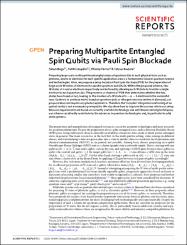| dc.contributor.author | Buğu, Sinan | en_US |
| dc.contributor.author | Özaydın, Fatih | en_US |
| dc.contributor.author | Ferrus, Thierry | en_US |
| dc.contributor.author | Kodera, Tetsuo | en_US |
| dc.date.accessioned | 2020-03-23T11:55:37Z | |
| dc.date.available | 2020-03-23T11:55:37Z | |
| dc.date.issued | 2020-02-26 | |
| dc.identifier.citation | Buğu, S., Özaydın, F., Ferrus, T. & Kodera, T. (2020). Preparing multipartite entangled spin qubits via pauli spin blockade. Scientific Reports, 10(1), 1-8. doi:10.1038/s41598-020-60299-6 | en_US |
| dc.identifier.issn | 2045-2322 | |
| dc.identifier.uri | https://hdl.handle.net/11729/2285 | |
| dc.identifier.uri | http://dx.doi.org/10.1038/s41598-020-60299-6 | |
| dc.description.abstract | Preparing large-scale multi-partite entangled states of quantum bits in each physical form such as photons, atoms or electrons for each specific application area is a fundamental issue in quantum science and technologies. Here, we propose a setup based on Pauli spin blockade (PSB) for the preparation of large-scale W states of electrons in a double quantum dot (DQD). Within the proposed scheme, two W states of n and m electrons respectively can be fused by allowing each W state to transfer a single electron to each quantum dot. The presence or absence of PSB then determines whether the two states have fused or not, leading to the creation of a W state of n + m − 2 electrons in the successful case. Contrary to previous works based on quantum dots or nitrogen-vacancy centers in diamond, our proposal does not require any photon assistance. Therefore the ‘complex’ integration and tuning of an optical cavity is not a necessary prerequisite. We also show how to improve the success rate in our setup. Because requirements are based on currently available technology and well-known sensing techniques, our scheme can directly contribute to the advances in quantum technologies and, in particular in solid state systems. | en_US |
| dc.language.iso | eng | en_US |
| dc.publisher | Nature Research | en_US |
| dc.relation.isversionof | 10.1038/s41598-020-60299-6 | |
| dc.rights | info:eu-repo/semantics/openAccess | en_US |
| dc.subject | Charge noise | en_US |
| dc.subject | Semiconductor quantum dots | en_US |
| dc.subject | Quantum dots | en_US |
| dc.title | Preparing multipartite entangled spin qubits via pauli spin blockade | en_US |
| dc.type | article | en_US |
| dc.description.version | Publisher's Version | en_US |
| dc.relation.journal | Scientific Reports | en_US |
| dc.contributor.department | Işık Üniversitesi, Fen Edebiyat Fakültesi, Enformasyon Teknolojileri Bölümü | en_US |
| dc.contributor.department | Işık University, Faculty of Arts and Sciences, Department of Information Technologies | en_US |
| dc.contributor.authorID | 0000-0002-9887-3509 | |
| dc.contributor.authorID | 0000-0002-5872-9158 | |
| dc.identifier.volume | 10 | |
| dc.identifier.issue | 1 | |
| dc.identifier.startpage | 1 | |
| dc.identifier.endpage | 8 | |
| dc.peerreviewed | Yes | en_US |
| dc.publicationstatus | Published | en_US |
| dc.relation.publicationcategory | Makale - Uluslararası Hakemli Dergi - Kurum Öğretim Elemanı | en_US |
| dc.contributor.institutionauthor | Özaydın, Fatih | en_US |
| dc.relation.index | WOS | en_US |
| dc.relation.index | Scopus | en_US |
| dc.relation.index | PubMed | en_US |
| dc.relation.index | Science Citation Index Expanded (SCI-EXPANDED) | en_US |
| dc.description.quality | Q2 | |
| dc.description.wosid | WOS:000563209800018 | |
| dc.description.pubmedid | PMID:32103078 | |



















